The Basics of Hardwood-Log Shiitake Mushroom Production and Marketing
ID
ANR-102P (ANR-329P)
EXPERT REVIEWED
Shiitake mushroom production offers an income opportunity for Virginia’s small-farm operators and small-woodlot owners while providing enjoyment for others. It is also a relatively simple food-production activity, like gardening, that can be a hobby or used for teaching. This publication describes a technique for shiitake production and marketing that can be used and adapted by Virginia farmers, hobbyists, or teachers. It describes common techniques based on the available research, as well as areas of disagreement and typical difficulties producers may face, such as pests. In addition to production methods, this publication describes some of the basics of the finances and marketing of shiitake mushrooms for those interested in using them for income production.
Shiitake mushrooms (Lentinula edodes) are the fruiting bodies of a fungus species native to Asia, where they have been consumed for centuries. They have a distinctive flavor and have become popular in the United States over the past 30 years. Shiitake mushrooms have been reported to have beneficial health effects, including lowering blood cholesterol levels, and there is some evidence of antiviral and anti-tumor benefits (Jong and Birmingham 1993). They also contain protein, vitamins, and antioxidants.
There are two basic ways, each with variations, to produce shiitake mushrooms (Przybylowicz and Donoghue 1988): on hardwood logs or on bags of compressed sawdust and other materials. The log production technique is described in this publication. The sawdust technique produces mushrooms faster and at a much higher efficiency but requires a larger investment in time, indoor space, supplies, and equipment.
The log production technique (fig. 1) produces a more desired product, is relatively simple, and is appropriate for novice mushroom growers and small-scale production for home use, sale at farmers markets or community supported agriculture. Still, the log production technique can support a larger enterprise, and some producers expand to maintaining hundreds or thousands of logs. Another of the advantages of log production is that, once inoculated and after a waiting period (usually six to 18 months), the same logs will continue to fruit for three, four, or more years. Mushrooms grown on hardwood logs sold for $10 to $20 per pound retail in Virginia in 2012 and $4 to $8 per pound wholesale (price estimates based on conversations with several producers).
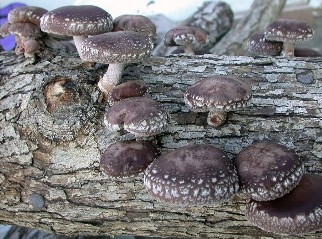
Hardwood log mushrooms are considered non-timber forest products, meaning they come from the woods. The mushrooms need a moderate to high level of shade and humidity to grow well. Many small-farm owners and other landowners have a small woodlot that otherwise might not generate any income annually.
Many small woodlots in Virginia are overstocked with poor-quality trees. It can make good economic sense to take out trees that have poor form, are suppressed, or are in decline. This allows higher quality timber trees to increase their growth. Some poor-quality timber trees could then be used to produce income in a shorter time period than from timber, by growing mushrooms. Alternatively, producers could use the tops and branches of trees that are left over after a timber harvest on their own or a neighbor’s property because this material is not often utilized.
How to Grow Shiitake Mushrooms on Hardwood Logs
There is no single way to grow shiitake mushrooms on logs. The directions below provide a general description of the steps. However, some producers have found that slight variations work better for them.
1. Plan Ahead
Shiitake mushroom production usually works best on hardwood logs that are cut from live trees after leaves fall in autumn and before leaf buds open in spring, and are inoculated a few weeks after. This is when the most sap is in the logs rather than in the buds and leaves. If that time period is not feasible, any time in the winter would be the second-best choice. Production will be reduced if summer logs are used.
There are contradicting and inconclusive research results about how soon after cutting the live tree the logs should be drilled and inoculated (Przybylowicz and Donoghue 1988). The answer may depend on the time of year the log is cut (a tree’s defenses are more active in summer) and the weather (humidity, temperature). Some suggest waiting four to eight weeks to allow the tree’s natural fungus-fighting defenses to die off, while others suggest inoculating as soon as possible after cutting the tree to prevent the log from over-drying or keep competing fungi from contaminating the log. A compromise approach of two to four weeks may work best, but producers should experiment with which approach works best for them.
2. Obtain Supplies
Shiitake Mushroom Spawn
You will need to purchase sawdust or “plug” spawn from a reliable source (fig 2). These suppliers may also sell a sawdust spawn inoculation tool that can help to measure and insert a more precise amount of spawn. Following are some relatively well-known vendors:
Everything Mushrooms – everythingmushrooms. com, 865-329-7566
Field and Forest Products – www.fieldforest.net, 800-792-6220
Fungi Perfecti – www.fungi.com, 800-780-9126
Mushroom Mountain – www.mushroommountain. com, 864-859-3080
Mushroom People – www.mushroompeople.com, 931-964-4400
Northwest Mycological Consultants – www.nwmycol.com, 541-753-8198
Sharondale Farm, Keswick, Va. – www.sharondalefarm.com, 434-296-3301

Green Logs
White oak logs, freshly cut from a living tree, are recognized as the best for shiitake production. If white oak is not available, several other hardwood trees, including other oaks, sweetgum, hornbeams, beech, birch, hickories, and others will produce mushrooms at a reasonable rate (Przybylowicz and Donoghue 1988; Bruhn, Mihail, and Pickens 2009). The production rate will depend on interactions between the strain of shiitake, tree species, and site conditions. There are different shiitake strains that will do well on different trees and in different weather conditions. If producers can use suppressed or deformed trees from their own woodlots, they can combine two jobs in one (timber stand improvement and mushroom production). It is important to use safe chainsaw techniques when cutting trees.
Select logs with more sapwood and a minimal amount of heartwood (tops and branches tend to work well) and no visible rot. Heartwood contains chemicals that are resistant to fungi growth (Przybylowicz and Donoghue 1988).
The traditional size for shiitake logs is 4 feet long with a 4- to 6-inch diameter. However, some producers have found that thicker, shorter logs work well, too. What is important is that the producer uses a size of log that is small enough to easily lift and handle, but not so small that it will dry out quickly. Logs should not have extensive damage to the bark or be covered in soil.
After cutting the logs, you may choose to wait a few weeks before drilling and inoculating them, as described in the previous section, Plan Ahead.
Drill or Angle Grinder and Bit
Holes must be drilled into the logs to inoculate them. For sawdust spawn, a 12 mm drill bit with a stop works well. These bits can be purchased from most mushroom suppliers. Most plug spawn is made for use with a 5/16-inch bit. A high-speed drill or modified angle grinder, if available, can help make the process less tedious.
Plugging/Sealing Material
If using sawdust spawn, once the logs are inoculated, the producer will need to plug or seal the holes. One option is to use paraffin or cheese wax, which can be purchased from most mushroom suppliers. Another option is 0.5-inch (12.7 mm) diameter polyfoam “backer rod” or “caulk saver,” which fits snugly in the 12 mm holes. Backer rod is a material used for caulking projects that can be purchased at local hardware stores for about $3.50 per 20 feet.
3. Drill and Inoculate Logs
Drill holes in rows along the length of the log, approximately 4 to 6 inches between holes, and 2 to 4 inches between rows. The benefit of a higher inoculation rate (more holes per log) is that fruiting may occur somewhat sooner, and it may reduce competing fungi. A lower inoculation rate (fewer holes) may save a little time and money on spawn and generally will still have good fruiting somewhat later with a little more risk of competing fungi. The fungus grows faster along the length of the log, so it is more important to have holes closer around the circumference (Przybylowicz and Donoghue 1988).
When using sawdust spawn, insert a small amount of mushroom spawn, about equal to the size of the tip of a pinkie finger or a “thimbleful,” into the drilled holes (fig. 3). Some of the companies listed in Step 2 (Obtain Supplies) sell inoculation tools that help measure and insert a more precise amount of spawn. Then, plug the hole with a small (about 3/8-inch long) piece of backer rod or seal with hot wax. The wax method requires a heat source and a brush, sponge, or baster to spread the wax. The plug/seal is especially critical for the first few days after inoculation. It accomplishes two things: It maintains spawn moisture as the fungus grows into the log, and it prevents contamination from other fungi.

When using dowel-rod plug spawn, gently tap the plug into the hole until flush with the bark or slightly below. There is usually no need to cover with polyfoam plugs or wax.
If the logs have been sitting for a long time between tree harvest and inoculation and are dry, they may need to have water poured over them after inoculation, or they may even need to be soaked before inoculation. Some producers prefer to cover the log ends with wax to maintain moisture and limit areas where competing fungi can enter.
4. Stack in the Shade (Incubation/ Spawn Run)
Four-foot logs can be stacked “log-cabin”* style or “crib” style. Other methods include leaning logs side by side against a horizontal wire or pole to create a low A-frame or lean-to. Shorter, thicker logs can be stood on end. Stacking the logs in such a way will help minimize contact with the ground and allow some airflow, which will reduce competing fungi, termites, and other pests. The logs can also be stacked on top of pallets, rocks, or other surfaces. A more horizontal or slightly angled orientation during this period will allow for more absorption of water from rain and snow but stacking logs directly over other logs may result in the top logs blocking rain from the logs directly below them.
Shiitake fungus needs shade during incubation; 60 to 85 percent shade is recommended (Przybylowicz and Donoghue 1988). Dappled sunlight under a forest’s canopy can be an ideal location, although it is possible to use artificial structures.
The shiitake fungus will grow through the log for six to 18 months before they begin to produce the fruiting bodies (mushrooms). This period is called the incubation or “spawn run” period. The amount of time depends on several factors, including inoculation rate and season, wood species, weather, and incubation site. Inoculating in the winter or early spring with good conditions should bring about some fruiting in the following fall, On oak logs, the second and third years will produce mushrooms in greater quantities, and the logs should have a production life of four to five years (Bruhn, Mihail, and Pickens 2009). Other types of logs, such as sweetgum, might produce as well in the first year or two and then drop off in production.
For optimal shiitake growth, the log moisture should be 35 to 55 percent by weight. If the log moisture drops significantly, the fungus can die. Virginia’s climate usually provides adequate moisture for shiitake, as long as the logs are in the shade and receive rain. However, monitor the weather for hot dry periods and irrigate the logs accordingly.
For a more precise method, monitor the moisture content of logs by weighing, drying, and reweighing a few sacrificed logs to estimate the water content of the logs at inoculation. Then periodically monitor the weight of inoculated reference logs, to know when they are get- ting close to being too dry. The method is described in Przybylowicz and Donoghue (1988).
5. Soak Logs and Produce Mushrooms
The completion of the spawn run is seen once the ends of the logs start to have a white, mottled appearance (fig. 4). This means the shiitake is ready to fruit. Outdoors, fruiting can take place during the spring, summer, and fall, depending on the weather and shiitake strain.
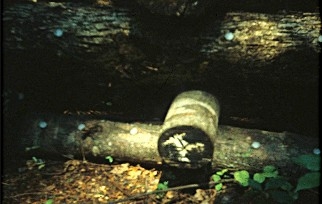
* Both the log-cabin and crib styles refer to stacking logs by laying one row of logs flat on the ground or other surface, then another row flat on top of that row but rotated 90 degrees. The stack could continue upward for six or eight rows (a taller stack may be unstable). Log-cabin style means that each row has only two logs with a wide space in the middle of the stack. This style most likely allows more rainfall to make its way to the lower rows. The crib style uses space more efficiently by having more logs (four or five) per row.
Logs can be forced to produce more rapidly by fully immersing them in cold water for 24 hours (fig. 5). After removing from the water, restack the logs in an orientation that allows the best access to mushrooms on all sides of the log, for instance in an A-frame or lean-to orientation. Tiny mushrooms should be visible in a few days and will be ready for harvest within about a week to 10 days. Those producing for market should consider protecting the mushrooms from rain, which will degrade their quality.
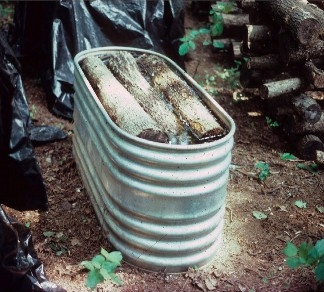
A small pocketknife or utility knife will work to harvest the mushrooms. Stems can be tough and are not generally considered a valuable part of the fresh mushrooms, although there may be ways to utilize the stems when dehydrated or ground. It is important to harvest your shiitake mushrooms promptly, while the caps are still somewhat rounded, before they flatten out. This is generally perceived to be the highest quality mushroom for flavor and freshness. Also, harvesting promptly reduces the amount of time that the mushrooms can attract pests like slugs. Other pests and prevention techniques are described in the next section, Pests Affecting Shiitake Mushrooms.
After mushroom harvest, the fungus will need a resting period before the logs can be soaked again. The length of the resting period may be for several weeks and depends on various factors, including weather, fungus strain, and type of log (Przybylowicz and Donoghue 1988).
Shiitake mushrooms are fairly well-known in Virginia’s larger cities and white-tablecloth restaurants. If selling the mushrooms, see ideas in the Marketing and Finance of Shiitake Mushrooms section.
Pests Affecting Shiitake Mushrooms
Pests and competing fungi may affect shiitake mushroom production. Fortunately, there are not many that cause serious problems. The main problems are usually from other fungi that affect the log and shiitake fungus that is contained within the log (fig. 6). Mushrooms should be harvested quickly before the mushroom caps flatten out to reduce time available for pests to do significant damage to the actual mushrooms. Following are a few of the most common competitors and pests, as well as preventive suggestions (adapted from Bak and Kwon 2005).
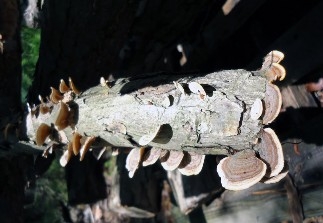
Fungi
Many fungi can impact shiitake production. There are fungi that compete with shiitake for the nutrients in the log, fungi that create conditions that are inhospitable to shiitake (such as drying the log), and others that directly attack shiitake.
Prevention: Inoculate logs in a timely manner after cutting to provide the best chance to establish a strong shiitake colony in the logs before competing fungi get a head start. Provide adequate ventilation and drainage and ensure the logs are in the shade and do not get too dry. If possible, keep logs off the soil and away from other possible contamination vectors. Logs that are seriously infected with competing or diseased fungi should be removed from the site.
Beetles
Some beetles can cause damage by digging under the bark in the larval phase or by introducing other fungi. The log will dry out if the bark falls off and the shiitake mycelia will die.
Prevention: Consider covering the logs with a mesh to keep beetles from laying eggs on the logs.
Soldier Beetles
These small bugs can be seen in the gills on the underside of the mushrooms. They do not harm the mushroom but actually eat tiny mites that cannot be seen with the naked eye.
Prevention: Harvest mushrooms quickly while caps are still rounded.
Treatment: After harvest, it is possible to blow the soldier beetles out of the mushrooms with a hair dryer.
Slugs and Snails
Slugs and snails can be a serious problem, especially in moist weather (fig. 7).
Prevention and treatment: Regularly hand-pick and destroy any slugs you find. Provide adequate ventilation and drainage. Eliminate places where snails and slugs feed, shelter, and reproduce, such as rotting wood, leftover materials like flats and boxes, and dead plant material. Decoy and trap snails with cabbage or lettuce leaves and promptly remove any snails you find. Lime, wood ash, or copper barriers can deter slugs and snails, and many gardening stores sell other products. Fowl such as ducks or chickens can also help control slugs.

Mammals (mice, squirrels, deer, rabbits)
Some wild and domestic animals have been noted feeding on shiitake.
Prevention: A variety of techniques may be effective, including fences, wire screens, or other barriers or repellents. Harvest mushrooms quickly.
Marketing and Finance of Shiitake Mushrooms
Because shiitake production on hardwood logs does not require a lot of expensive specialized equipment, producers can experiment with production and test markets with a small-scale production of 100 logs or fewer. Before investing time in a larger scale operation, it is highly recommended that potential producers research possible markets and develop a business plan.
Part of the business plan should focus on obtaining an adequate supply of logs. One of the most challenging parts of medium- to large-scale shiitake production (more than 100 logs per year) is obtaining enough logs to ensure a consistent supply of mushrooms. Most shiitake producers and owners of small areas of forest- land do not have enough trees of the right type (small, deformed, suppressed oaks and other species) to fully supply their own logs. Virginia has plenty of hardwood forests and trees that are not used to their full potential. Still, some loggers and arborists may not be receptive at first to “unusual” requests that require them to put extra time and effort into their operations. Work to develop a relationship with these businesspeople and help them understand the shiitake mushroom business is a potential market for their product.
Also, investigate food handling and safety regulations. Contact the Virginia Department of Agriculture and Consumer Services (www.vdacs.virginia.gov/) to explore regulations on inspection and labeling, especially if the plan is to include extra handling or value-added activities.
Marketing Plan
For the marketing part of the business plan, consider the following steps:
Identify target customers. Who is most likely to buy the product? Although demand for shiitake is growing, it is still a relatively small market and fairly unknown in many small towns and rural areas of Virginia. Also, mushrooms generally are consumed in higher proportion by Asian-Americans and white Americans, and by middle-to-upper-income families who value natural health products and local/natural food products (Ofori-Boadu and Nartea 2006).
Explore marketing channels. Determine where target customers shop, the relationship they prefer with farmers, and who the competitors may be. Producers are more likely to find markets for shiitake in larger metropolitan areas, in places such as farmers markets, restaurants, bed and breakfasts, natural food stores, and community supported agriculture. Some supermarkets are receptive to local growers but may have stricter requirements for insurance, quality control, and consistent supply throughout the year.
Search for markets for additional spinoff products that could be sold. Examples include drying mushrooms that are not graded to sell fresh, selling pre-inoculated logs, or grinding up the unused portions of the mushroom stem into a fine powder that can be used as a seasoning in soup stock.
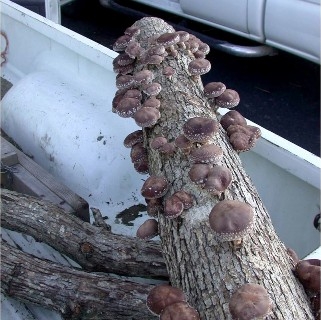
When seeking buyers, it may be beneficial for producers to develop some brochures or flyers, an Internet site, or other methods for informing people about the production, the product, and themselves (fig. 8).
Finance
The appendix provides a budget for 500 logs of shiitake production that was developed to help producers get a handle on the costs involved and the potential profitability. Of course, costs and revenues will vary from producer to producer. Based on anecdotal knowledge of the shiitake market and research on other factors, the yield, costs, and revenues are somewhat conservative, meaning most producers have higher profits than those shown here, although it is certainly possible for a producer to have lower profits, or even a loss if markets are not favorable.
Note that the budget includes the costs of the producer’s labor. Many people tend to forget or undervalue their own labor. Time is money! Unless a producer just truly loves the work involved in growing mushrooms, remember that every minute spent inoculating logs or marketing mushrooms is a minute that could have spent doing something else, such as working off-farm or spending time with family. The budget here includes a higher wage rate for skilled jobs like sales, promotion, and marketing compared to production activities because good marketing requires skill and knowledge.
The sample budget provides several summary statistics at the bottom of the page. The break-even price is the minimum price a producer must obtain per pound of shiitake in order for revenues to cover costs, given the assumptions about prices of inputs and shiitake production yield. The costs include the cost of the producer’s labor, so if the mushrooms sell at exactly the break-even price, the producer could afford to pay himself or herself an amount per hour equal to the wage rates shown.
The break-even yield is the amount of mushrooms that would need to be sold over the four-year period for revenues to cover costs (including labor). The break-even wage is the amount available to pay for all labor activities (in this case, marketing is lumped together with production activities), if the assumptions about other costs, yield, and mushroom price hold true.
Internal rate of return is simply the interest rate a producer can expect to earn by investing money and time in this project. While this concept is easy to understand for most people, net present value (NPV) is less understood. Basically, NPV estimates the return on investment in dollar terms but takes into account the alternatives available for investing money (savings account, stock market) that might earn a reasonable rate of return — for example, 7 percent. NPV is the amount of money above that 7 percent discount rate that shiitake production will earn.
Additional Resources
Websites
North Carolina Cooperative Extension – www.ces.ncsu.edu/fletcher/programs/herbs/crops/mushrooms/
University of Missouri, Center for Agroforestry – www.centerforagroforestry.org/
U.S. Department of Agriculture, National Agroforestry Center – http://nac.unl.edu/
Virginia Cooperative Extension - www.ext.vt.edu
Books
Chang, S. T., and P. G. Miles. 2004. Mushrooms: Cultivation, Nutritional Value, Medicinal Effect, and Environmental Impact. 2nd ed. Boca Raton, Fla.: CRC Press.
Przybylowicz, P., and J. Donoghue. 1988. Shiitake Growers Handbook: The Art and Science of Mushroom Cultivation. Dubuque, Iowa: Kendall/Hunt.
Stephenson, S. L. 2010. The Kingdom Fungi: The Biology of Mushrooms, Molds, and Lichens. Portland, Ore.: Timber Press.
Acknowledgements
Thanks to the following people for providing information and reviews that contributed to this publication: Andy Hankins, Marcus Comer, and Theresa Nartea, Extension specialists, Virginia State University; John Munsell, Extension specialist, Virginia Tech; Bill Worrell and Jason Fisher, Extension agents, Virginia Cooperative Extension; Mark Jones, owner, Sharondale Farm; Joshua Idassi, Extension specialist, North Carolina A&T State University; and Omoanghe Isikhuemhen, assistant professor, North Carolina A&T State University.
References
Bak, W.-C., and H. Kwon. 2005. “Biology and Control of Pests and Diseases in Shiitake Log Cultivation.” In Mushroom Growers’ Handbook 2: Shiitake Cultivation, 152-61. Seoul, Korea: MushWorld.
Bruhn, J. N., J. D. Mihail, and J. B. Pickens. 2009. “Forest Farming of Shiitake Mushrooms: An Integrated Evaluation of Management Practices.” Bioresource Technology 100:6472-80.
Jong, S. C., and J. M. Birmingham. 1993. “Medicinal and Therapeutic Value of the Shiitake Mushroom.” In Advances in Applied Microbiology, Vol. 39, edited by S. Neidleman and A. I. Laskin, 153-184.
Ofori-Boadu, V., and T. J. Nartea. 2006. Marketing Strategy for Shiitake Mushrooms in North Carolina. Edible and Medicinal Mushroom Farming in North Carolina: A Cash Crop for the Future. North Carolina Agricultural and Technical State University Executive Report for the Golden Leaf Foundation. Rocky Mount: North Carolina A&T State University.
Przybylowicz, P., and J. Donoghue. 1988. Shiitake Growers Handbook: The Art and Science of Mushroom Cultivation. Dubuque, Iowa: Kendall/Hunt.
Appendix. Shiitake Mushroom Budget (500 logs)
No. logs Production Pounds of mushrooms produced Pounds sold fresh (20% cull) |
0 |
1 |
Year 2 3 |
4 |
|||
500 0 0 |
500 50 40 |
500 500 1,000 750 800 600 |
400 300 240 |
||||
Establishment costs |
Qty Unit |
Price/unit ($) |
$ |
$ |
$ $ |
$ |
|
Equipment use |
|||||||
Chain saw (deprec, |
8 hr |
2.75 |
22.00 |
||||
maint, fuel)a |
|
|
|
||||
Drill (deprec, maint, |
8 hr |
1.50 |
12.00 |
||||
elec) |
|
|
|
||||
Pickup truck (deprec, |
200 mi |
0.56 |
111.00 |
||||
maint, fuel)b |
|
|
|
||||
Refrigerator (deprec, |
14 days |
0.67 |
9.44 |
||||
maint, elec)c |
|
|
|
||||
Materials |
|||||||
Fresh white oak logsd |
500 logs |
1.00 |
500.00 |
||||
Drill bits |
5 bits |
12.00 |
60.00 |
||||
Sawdust spawn (5-lb |
7 bags |
22.00 |
154.00 |
||||
bag) |
|
|
|
||||
Polyfoam plugs (20-ft |
16 pkg |
3.50 |
56.00 |
||||
pkg) |
|
|
|
||||
Water tank |
1 tank |
100.00 |
100.00 |
||||
Heavy-duty 100-ft hose |
1 hose |
42.00 |
42.00 |
||||
Labor |
|
|
|
||||
Prepare site |
8 hr |
10.00 |
80.00 |
||||
Cut logs |
24 hr |
10.00 |
240.00 |
||||
Drill, inoculate, plug logs |
40 hr |
10.00 |
400.00 |
||||
Stack logs |
4 hr |
10.00 |
40.00 |
||||
Variable costs |
|||||||
Equipment use |
|||||||
Pickup truck (deprec, |
4 mi/lb |
0.56 |
– |
88.80 |
1,776.00 |
1,332.00 |
532.80 |
maint, fuel |
|
|
|
|
|
|
|
Refrigerator (deprec, |
0.25 day/lb |
0.67 |
– |
6.74 |
134.79 |
101.10 |
40.44 |
maint, elec) |
|
|
|
|
|
|
|
Materials |
|||||||
Box to hold 3 lb |
0.33 box/lb |
0.60 |
– |
7.99 |
159.84 |
119.88 |
47.95 |
mushrooms |
|
|
|
|
|
|
|
150-qt cooler to |
2 coolers |
100.00 |
– |
200.00 |
– |
200.00 |
– |
transport, hold |
|
|
|
|
|
|
|
Ice |
0.50 lb |
1.10 |
|
2.00 |
40.00 |
30.00 |
12.00 |
Misc utilities (light, |
|
|
100.00 |
100.00 |
100.00 |
100.00 |
100.00 |
water, etc.) |
|
|
|
|
|
|
|
Labor |
|||||||
General inspection and |
hr |
10.00 |
350.00 |
350.00 |
350.00 |
350.00 |
350.00 |
maintenance |
|
|
|
|
|
|
|
Soak logs |
hr |
10.00 |
– |
350.00 |
350.00 |
350.00 |
280.00 |
Harvest |
hr |
10.00 |
– |
24.00 |
480.00 |
360.00 |
144.00 |
Sales, promo, mktg |
hr |
18.00 |
– |
144.00 |
2,880.00 |
2,160.00 |
864.00 |
Hauling |
hr |
10.00 |
– |
40.00 |
800.00 |
600.00 |
240.00 |
Costs less labor |
|
|
$1,926.44 |
$405.53 |
$2,210.63 |
$1,882.98 |
$733.19 |
Total costs |
|
|
$2,276.44 |
$1,313.53 |
$7,070.63 |
$5,702.98 |
$2,541.19 |
Break-even price (4 yr) |
|
$11.25/lb |
|
|
|
|
|
Revenues |
|
|
0 |
1 |
Year 2 |
3 |
4 |
Fresh shiitake |
[see lb |
$12.50 |
$ – |
$500.00 |
$10,000.00 |
$7,500.00 |
$3,000.00 |
mushrooms |
above] |
|
|
|
|
|
|
Break-even yield at this |
1,512 lb |
|
|
|
|
|
|
price |
|
|
|
|
|
|
|
Break-even wage |
$10.40/ hr |
|
|
|
|
|
|
Internal rate of return |
26% |
|
|
|
|
|
|
Net present value |
$1,339.00 |
|
|
|
|
|
|
![]()
a From USFS NEFES. Research Paper NE-‐582
b Based on IRS estimate for depreciation, maintenance, and fuel of private vehicle.
c Cost of standard refrigerator estimated at $1,000 with life of 10 years. 5 kWh/day * $0.08.
d Estimate based on 2013 Virginia average cost of mixed hardwood pulpwood. May vary depending on availability of logs. Alternatively, this cost could represent the opportunity cost of the wood plus the labor required to fell and skid trees.
Virginia Cooperative Extension materials are available for public use, reprint, or citation without further permission, provided the use includes credit to the author and to Virginia Cooperative Extension, Virginia Tech, and Virginia State University.
Virginia Cooperative Extension is a partnership of Virginia Tech, Virginia State University, the U.S. Department of Agriculture (USDA), and local governments, and is an equal opportunity employer. For the full non-discrimination statement, please visit ext.vt.edu/accessibility.
Publication Date
November 4, 2025



